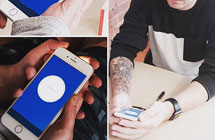世界上首款皮外检测血糖水平的APP
|
The world's first health app could monitor people's glucose levels without breaking the skin - a development which has been described as the 'holy grail' in diabetes care. The Epic app could also help people find out if they could develop diabetes and need to make lifestyle changes to avoid it becoming a reality. Users will be able to find out how different food types affect their body; for example, what a can of coke will do to their sugar levels or heart rate or how a plate of broccoli lowers their blood pressure.
It will also be possible to see how exercise or supplements affect vital statistics. Users will only have to place one fingertip over the camera lens of their smartphone, the London-based firm has stated. A series of close-up images are taken which accurately show information about the user's blood flow. These are then sent to the cloud for analysis and can provide feedback on all kinds of vital information - from heart rate to temperature to blood pressure. It can also tell people about their respiration and blood oxygen saturation. SMBG (self-monitored blood glucose) is recommended for all people with diabetes and the clinical benefits are widely accepted. Developers say the app will be available to download - free of charge - on Android smartphone devices and iOS at the end of this year. Almost all pre-existing glucose monitoring equipment is invasive - and many companies including Apple have talked of trying to develop a non-invasive method of testing. Diabetes is a chronic disease that occurs either when the pancreas does not produce enough insulin or when the body cannot effectively use the insulin it produces. Insulin is a hormone that regulates blood sugar. The number of people with diabetes has risen from 108 million in 1980 to 422 million in 2014. Another development of the app means that users will be able to measure their Insulin Resistance levels in a completely non-invasive way, to determine if they are pre-diabetic. To measure this, the Epic app measures the variation in user's pulse which is related to blood glucose concentration. It is far less complex and more accurate than other ways of monitoring, developers say. |









